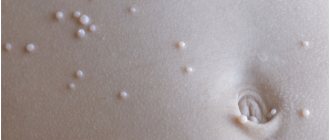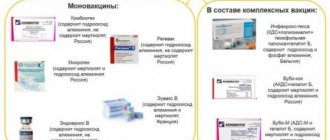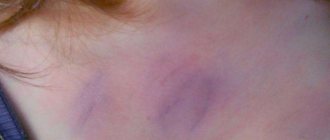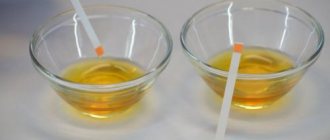Uses of baking soda
The use of baking soda is advisable in:
- Food industry - production of confectionery, bakery, preparation of drinks;
- Chemical industry - for the production of foam plastics, dyes, household chemicals, fluoride reagents;
- Light industry - production of artificial leather, sole rubber, textiles.
- Medicine - as a means to reduce the acidity of gastric juice, as well as neutralize skin burns with acids.
In addition, sodium bicarbonate is part of the powder used in fire extinguishing - its action is based on displacing oxygen from the site of fire with the help of carbon dioxide.
Interaction of baking soda with acids
Sodium bicarbonate reacts with acids. The ion exchange reaction is accompanied by the formation of salt and weak carbonic acid. At the moment of receipt, it decomposes into water and carbon dioxide (evaporates).
The walls of the human stomach produce hydrochloric acid, which exists in the form of H+ and Cl– ions. If you take sodium bicarbonate orally, reactions occur in a solution of gastric juice with the participation of ions: NaHCO3 = Na+ + HCO3–; HCl = H+ + Cl–; H2O ↔ H+ + OH–; HCO3– + H+ = H2O + CO2↑. Doctors do not recommend constantly using sodium bicarbonate in case of increased stomach acidity. The instructions for the drugs list various side effects of daily and long-term use of baking soda:
- increased blood pressure;
- belching, nausea and vomiting;
- anxiety, poor sleep;
- decreased appetite;
- stomach ache.
Soda in the food industry
The main use of baking soda is, of course, cooking. The powder, familiar from childhood, is used as an additional or main leavening agent when baking. A small amount of soda (at the tip of a spoon) added to the dough will make the baked goods softer, fluffier and more easily digestible. To ensure that the product does not acquire the soapy taste characteristic of soda, it is necessary to maintain the correct proportions. When adding baking soda to water or fresh milk (not an acidic medium), it is customary to quench the product with vinegar - this way the unpleasant taste of sodium carbonate disappears from the dough. When mixing soda with sour cream, kefir or yogurt, it is not necessary to extinguish the baking soda.
Price, expiration date and storage rules
- Baking soda is one of the cheapest products. A half-kilogram package costs only 15 rubles.
- The guaranteed shelf life is 12 months, but in a dry place and secure packaging, the alkali retains its properties longer.
- When purchasing packaging, make sure it is intact. Powder in an unsealed package absorbs moisture and loses its beneficial properties. At home, it is advisable to pour the soda into a hermetically sealed glass or metal container and store it at room temperature.
- It’s easy to check the quality of the alkali - pour vinegar onto a spoon of powder. A violent reaction should occur, accompanied by hissing and the formation of foam.
Take advantage of all the beneficial properties of baking soda - quality is not always determined by price. The usual product seems outdated, but we use only part of its capabilities. We often chase beautiful packaging and advertised products, forgetting about the side effects of the latest medicines and detergents. Tea soda is completely harmless provided the correct dosage and moderate use.
Baking soda in medicine
The use of baking soda is not limited to cooking: the use of sodium bicarbonate in traditional and alternative medicine is widespread. Baking soda treatment is effective due to the substance’s ability to destroy microbes and also neutralize the effects of acids.
In order to get rid of painful heartburn or belching, just stir a teaspoon of soda in 1 glass of water and drink in one gulp.
Baking soda is used for colds and sore throats by gargling with a baking soda solution at the rate of 1 teaspoon of sodium bicarbonate per glass of warm water.
Baking soda is indispensable in the treatment of burns. If a burn occurs, you need to mix 1 teaspoon of baking soda with vegetable oil, apply to a cotton swab and apply to the sore spot. After some time, the pain will go away and the wound will heal quickly.
Treatment of boils, calluses and corns with baking soda is carried out using lotions with a strong soda solution or hot soda foot baths.
In order to quit smoking, it is practiced to rinse the mouth with a thick solution of soda in small doses so as not to disrupt the digestion process.
With the help of soda you can also:
- Treatment of alcoholism and tobacco smoking;
- Dissolution of deposits in the spine, joints, kidney and liver stones, treatment of radiculitis, rheumatism, osteochondrosis, gout, urolithiasis and cholelithiasis;
- Cleansing the body from salts of cadmium, lead, thallium, mercury, bismuth, barium and other heavy metals.
Harm and contraindications
Drinking baking soda with water is harmful and is not recommended for people:
- with hypersensitivity to the product (in rare cases, if consumed excessively, the product may cause an allergic reaction);
- people with low blood pressure (due to the fact that soda lowers blood pressure);
- pregnant women;
- during breastfeeding;
- patients with diabetes;
You can drink soda only in one teaspoon with a glass of water and only once a day in the morning on an empty stomach. In case of overdose, you may experience:
- nausea;
- vomit;
- headaches;
- stomach upset.
In such cases, it is necessary to reduce the dose, otherwise the recipient may experience convulsions. People who are sodium intolerant and have low acidity should also not drink soda.
Before taking this drink, we urge you to contact your doctor and only with his permission start taking it.
Baking soda in cosmetology
Hard water, hairsprays and sprays often make our hair weak and split. One tablespoon of soda added to a care product (shampoo or conditioner) will strengthen your hair, make it soft and shiny.
Baking soda is also used as a softening scrub for the skin. Mix 2 tablespoons of baking soda with your body moisturizer. Rinse your skin with water and use a washcloth to distribute the mixture over your entire body, paying attention to “problem” areas: elbows, knees, bikini area. This procedure will soften, cleanse the skin, and also relieve inflammation caused by razors.
Baking soda is an excellent remedy for restoring the PH balance of the skin and getting rid of acne. Dip a cotton swab into the baking soda and facial cleanser solution and begin to gently massage your skin in circular motions, avoiding the eye area. This procedure will remove dead skin particles and cleanse facial pores. Regular treatment will help get rid of acne completely.
What is the difference between a pharmaceutical substance and a food additive?
The medical substance NaHCO3 is produced in pharmaceutical factories to produce drugs. The drug undergoes in-depth purification. The content of toxic substances (in the form of arsenic, lead, mercury and harmful impurities) is strictly regulated by GOST and controlled at enterprises. The medical product tastes much better. Falsification is excluded.
Industrial baking soda is made on a different scale. The product is manufactured in accordance with GOST (Food additives. General technical conditions). The content of toxic substances meets safety requirements. There is no reason to worry about the increased content of harmful impurities, although the degree of purification is lower.
Expert opinion
Did you know?
The food component is recommended for beneficial home spa treatments. Add a spoonful of powder to the water and get a comfortable, satisfying bath.
In chemical terms, the nutritional composition is represented by sodium bicarbonate, and the pharmacological composition is sodium hydrogen phosphate dodecahydrate plus sodium dihydrogen phosphate dihydrate. Sold as phosphated soda.
Recommended for you:
How to treat mastopathy with soda at home
In medicine, a product with an increased level of purification is used, which meets the requirements of the Pharmacopoeia. The NaHCO3 ratio is ≥ 99.5%. Na2CO3 accounts for ≤ 0.5% with an insignificant presence of chlorides and sulfates.
For the correct purpose of a pharmaceutical substance, it is recommended to consult Mashkovsky’s prescription directory. According to pharmacological qualities, the substance is classified into several groups.
Product forms include powders and suppositories, injection solutions and specialized medications, tablets.
When packaging the Baking Soda product, GOST 32802-2014 is indicated. Mass ratio of NaHCO3 composition ≥ 99.0%. Na2CO3 fraction ≤ 0.7%. Other components are represented by iron and sulfates, calcium and chlorides, slightly soluble substances.
The qualitative composition of food products is fundamentally different from pharmaceutical products.
To find out where and how to buy a medical substance or baking powder at reasonable prices, it is recommended to use specialized online services. You will quickly find a cheap product at great deals.
Detailed descriptions with photos, adequate reviews and addresses of organizations will help you make the right decision. For example, inexpensive drinking soda is offered in the catalog of the online trading center regmarkets.
Baking soda for weight loss
The property of baking soda, which prevents the absorption of fats in the body, allows the use of sodium bicarbonate as a means of losing weight. However, it is necessary to take a soda solution only after consulting a doctor, with strict adherence to the dosage - otherwise the harm caused by baking soda to the body will be inevitable.
A safer way to lose extra pounds using baking soda is to use it in baths. The essence of the action of baking soda for weight loss is to activate the lymphatic system. A few drops of essential oils added to a soda bath accelerate the removal of waste and toxins from the body, and, consequently, the process of losing excess weight. In addition to the healing effect, baths with baking soda are wonderfully relaxing, helping to reduce fatigue and nervous tension.
Basic information about soda
There are several types of soda: soda ash - Na2СO3, bicarbonate (food soda) - NaHCO3, crystalline - Na2СO3•10Н2O and Na2СO3•Н2O, caustic - NaOH. According to the method of production, soda can be Leblanc or more pure ammonia. Although the soda we are accustomed to is a product of industrial production, mankind discovered the beneficial properties of alkali in prehistoric times, when natural soda was mined from lakes and small deposits.
Baking soda is a universal remedy not only for illnesses
Start of sodium bicarbonate production
Soda occurs naturally in a solid state as part of the mineral tron or in the water of some lakes and mineral springs. In addition, the substance can be obtained from the ash of certain plants. This is how the substance was mined until the beginning of the 19th century, but the need for soda was constantly increasing - it was necessary for the manufacture of soap, paints, glass, and medicine.
Currently, there are soda lakes in western Siberia and Transbaikalia. The most famous sources are Tanzanian Lake Natron and Californian Searls. Reserves of natural soda in the United States are so large that they cover almost half of the state's needs. There are no such large deposits in Russia and Europe, so soda is synthesized only by chemical methods from sodium carbonate and carbon dioxide.
The first to produce artificial soda from rock salt was the French chemist Leblanc in 1791. The recipe remained a secret for a long time and was the property of France. We can say that the specificity of French cuisine is explained by the fact that confectioners could obtain food alkali and were free to invent recipes for biscuits, puff pastries, and crumbly cookies. At this time, baking techniques using yeast were developing in Austria, Russia and other European countries. The trends continued until the 20th century and allowed Viennese craftsmen to reach unattainable heights in the preparation of the famous yeast rolls and cakes.
French chemist Nicolas Leblanc was the first to produce soda artificially.
Only 70 years after Leblanc, the Belgian Ernest Gaston Solvay developed an ammonia method for synthesizing soda from salt. The method was cheaper and better than Leblanc’s, and from the end of the 19th century it was switched to in Europe and the USA.
In Russia, soda dough won over yeast dough along with the development of the public catering network in the Soviet Union. Cooking is easier and the result is predictable, which cannot be said about yeast dough, so national traditions gradually gave way to quick and reliable cooking techniques.
You might be interested in: Sodium bicarbonate for the human body: more benefit or harm?
Composition of baking soda
Sodium bicarbonate is a fine, white, easily soluble powder in water. In reaction with acid, it forms water, which releases carbon dioxide. Weak alkali does not have a negative effect on body tissues and plants. Baking soda is in great demand; it is actively used in everyday life to maintain cleanliness, cooking, medicine, textile and chemical industries, metallurgy, etc.
The composition of sodium bicarbonate is the sodium salt of hydrocarbonate acid, which does not include proteins, fats and carbohydrates. The calorie content of the substance is zero. The minerals in baking soda are selenium and sodium.
Harm of baking soda
Despite the above benefits of sodium bicarbonate, baking soda, in addition to its benefits, can cause harm to our body. Uncontrolled ingestion of baking soda causes increased release of carbon dioxide, which is accompanied by even greater release of acid and bloating of the stomach - the so-called “acid rebound”.
Prolonged contact with baking soda powder may cause skin irritation and burns. Avoid getting baking soda in your eyes.
Video from YouTube on the topic of the article:
Chemical formula and its composition
Baking soda, despite its simple name in everyday life, is a complex chemical compound, therefore, it has a chemical formula - NaHCO3 (Figure 1).
Figure 1 – Chemical formula and structure of baking soda.
Consists of one molecule of sodium (Na), one molecule of hydrogen (H), one molecule of carbon (C) and three molecules of oxygen (O). It has several technical names - sodium bicarbonate, sodium bicarbonate, sodium bicarbonate. It is nothing more than an acidic salt of carbonic acid and sodium. All acidic salts begin with the prefix "hydro".
The name of soda requires clarification: it contains no proteins, no fats, no carbohydrates. Calorie content of soda – 0 kcal.
You can often hear the name - drinking, table or tea soda.
Baking soda looks like a white, loose powder with small crystalline particles. Has no smell.
Pharmacy soda according to Neumyvakin
Treatment with sodium bicarbonate according to Neumyvakin covers a list of serious diseases. The success of the professor’s technique attracted interest from medical professionals. Followers who periodically consume soda are grateful in reviews and provide recommendations in the media.
Recommended for you:
How to treat sinusitis with soda at home
Treatment according to Neumyvakin is not considered a panacea. Pharmacy sodium bicarbonate with unconventional methods help the body. The human body focuses its efforts on correcting the disturbed natural balance and increasing the protective level. The professor does not guarantee productive results in a short time.
Principles of treatment
Methods of benign healing according to Neumyvakin include the correct proportions of using the pharmaceutical drug, accepting the rules and following the recommendations.
3 main principles are characterized:
- Correctly selected balanced diet.
- Physical activity and cleanliness.
- A specially designed set of exercises.
Doctor of Medical Sciences Neumyvakin recommends starting treatment with soda with small preventive doses. In the absence of side effects, the dose is gradually increased. Literally within 15 minutes after 1 dose, the effect appears in the form of blood thinning and normalization of the structural composition.
A course of taking the drinking mixture results in stabilization of blood pressure, improved well-being and disappearance of joint pain. The imbalance that has been developing for a long time begins to be restored.
Acid-alkaline environment of the body. What should the indicator be?
The human body consists of alkalis and acids, while in a healthy body there should be 3-4 times more alkalis. This ratio is determined by the pH level. By this indicator we can judge the state of our health.
At birth, the pH of human blood is 7.5-7.3. With age, this indicator decreases due to non-compliance with the correct lifestyle, excess nutrition, and harmful influences of the external environment. In a healthy adult body, the blood pH should be in the range of 7.35 - 7.45, which is extremely rare, in most cases it does not exceed 7.15 - 7.20, and if the value is lower than 6.8 ( very acidic blood) a person’s death occurs, so-called acidosis (TSB, vol. 12, p. 200).
Causes of acidification in the human body
Causes of imbalance of acid-base levels in the body, leading to diseases:
- unhealthy diet, which contains a lot of protein foods and little plant foods;
- fast food, products high in preservatives, food additives, flavor enhancers, starch, sugar;
- polluted air, bad water, uncontrolled use of medications;
- negative emotions, stress, anger, anxiety, resentment, hatred;
- loss of mental energy leads to illness. Therefore, in the ancient teachings of Agni Yoga, it is recommended to take baking soda daily to restore energy centers and the psyche, and to prevent many diseases.
We conclude: in an acidic body all diseases easily coexist; in an alkaline body, on the contrary, the body recovers! So we should strive to alkalize our body, which is what ordinary tea soda successfully helps us with.
Important! However, to start treatment with soda, you should consult a doctor and remember that each body is individual. Therefore, we begin taking it carefully, observing the body’s reaction!
Baking soda treatment and oral administration
The temperature of soda solutions for internal use should be slightly hot, and in no case cold! We extinguish the soda with hot water at a temperature of +60º C.
At this temperature, sodium bicarbonate (the same baking soda from the pack) breaks down into sodium carbonate (soda ash), carbon dioxide and water:
2NaHCO3→ Na2CO3+H2O+Co2↑
Do not confuse here soda ash, obtained in the reaction (molecular form) from technical soda ash,
sold in stores!
It’s even better to use soda in hot milk (t+ 60º), which promotes better absorption into the blood.
Just as cold milk does not connect with tissues, so hot milk does not connect with soda and penetrates into the centers of cells. Helena Roerich
The concentration of soda in the solution is strictly individual for each organism. You can start with 1/5 tsp, or even 1-2 grams, dissolving them in hot liquid at a temperature of 60 degrees and gradually increase the dose to 1 tsp. Although some sources indicate a dose of up to 2 tsp.
An excess of soda in cold water is not absorbed and causes diarrhea. This property is used as a laxative. Another important feature of soda is that its excess is always excreted from the body through urine.
!The only limitation: you should refrain from using soda during periods of exacerbation of gastrointestinal diseases.!
- Softens cough and facilitates sputum discharge. Even for children, it is useful to take hot milk slightly higher than fresh (about 400) when coughing, with the addition of ½ teaspoon of soda per glass of milk. You can add half a spoonful of honey and a piece of butter to this;
- Treats seasickness due to its effect on the vestibular apparatus;
- Baking soda has a positive effect on heart function, improves heartbeat and eliminates arrhythmia;
- Leaches, dissolves all types of harmful deposits in joints, curing osteochondrosis, arthritis, arthrosis, polyarthritis, radiculitis, rheumatism, gout;
- Sodium bicarbonate relieves urolithiasis, stones in the liver, kidneys, gall bladder, and intestines.
- Soda is used in the treatment of alcoholism, drug addiction, and substance abuse;
- Treats cancer if you follow a diet (you need to exclude dairy products from your diet, which clog the lymph flow and sugar, which feeds cancer cells). Back in the 60s of the last century, at a closed conference, the causes of an increasingly growing disease - cancer - were indicated: acidification of the body. And ways to combat oncology were indicated - alkalization of the body, which is easily carried out with the help of baking soda. But doctors are in no hurry to share this discovery with their patients, prescribing expensive drugs and recommending unbearable procedures, including radiation. And it is clear that even after overcoming cancer, after such treatment a person is doomed to other ailments.
- Soda relieves heartburn (although doctors strongly recommend not to overuse soda , since in response to the action of soda, even more acid is formed in the stomach). This is true if you use soda during digestion, and if you drink soda on an empty stomach , then the mechanism of action is completely different: soda, being an antacid (anti-acid drug), entering the neutral environment of the stomach (this is exactly the acidity of gastric juice on an empty stomach) neutralizes excess acid and brings acidity back to normal.
- Medicine widely uses injections of soda solution in the treatment of various pulmonary diseases and respiratory systems complicated by myocardial infarction.
- When the body is weakened, when there is a loss of strength, or fatigue, soda gives a charge to red blood cells, thereby increasing vitality.
How to get rid of a hangover
The withdrawal state (hangover) is characterized by the accumulation in the body of a large number of various organic acids and their equivalents - acidosis develops. And in this case, ordinary baking soda is used to restore the disturbed acid-base balance.
Thus, with a relatively mild degree of withdrawal it is recommended to take up to 3-4 g of soda, with a moderately severe one - up to 6-8 g, with a severe one - up to 10 g. To correct acidosis, you can take 2 g of baking soda in the first 2-3 hours, dissolved in 200 ml of liquid, and within 12 hours - at least 7 g.
Another dosage regimen is as follows: on the first day, 2 g once and then 6 times over 12 hours, on the second day - 5 g over 13 hours, on the third - 3 g randomly. For emergency withdrawal from the withdrawal state, it is recommended to drink 1 liter of water in which 5 g of soda is dissolved during the first hour, and during the second hour at least half a liter with 3 g of soda. If, after taking the solution, pain occurs in the stomach due to the large amount of carbon dioxide formed, then the use of soda should be limited to 2 g per day.











